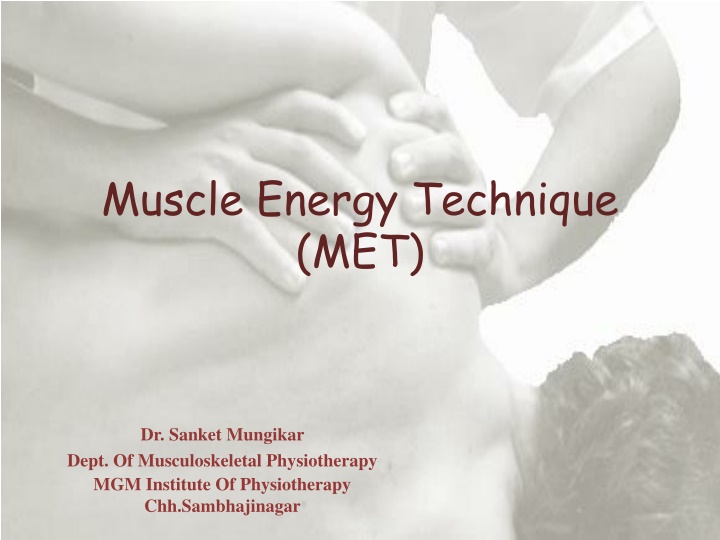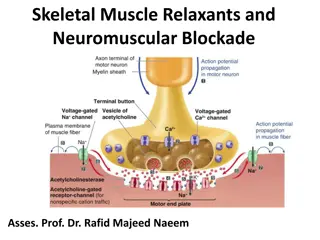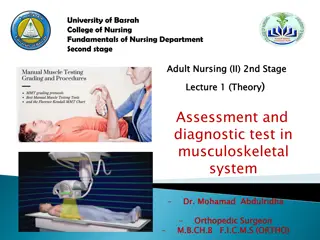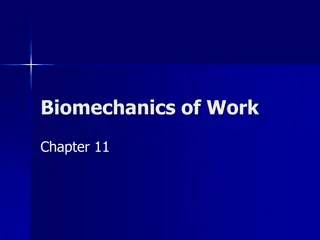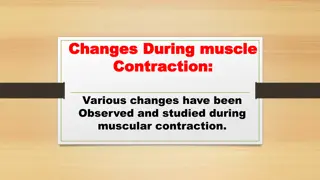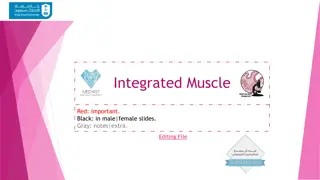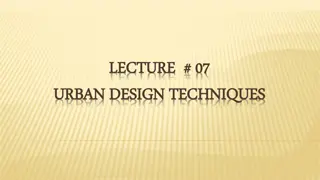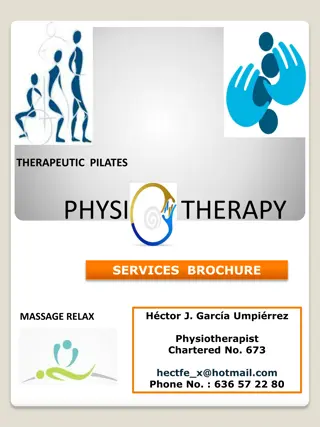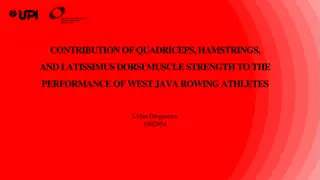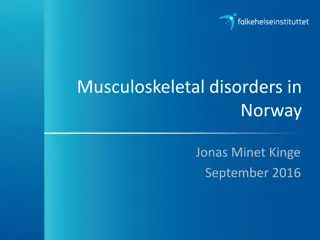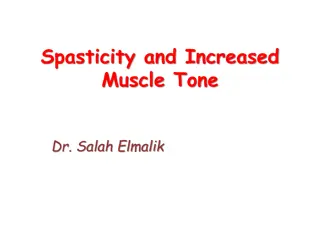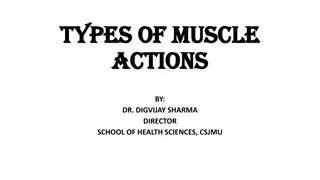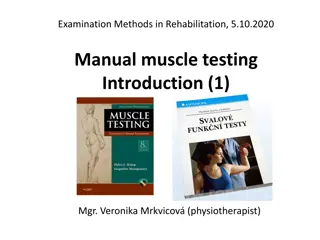Muscle Energy Technique (MET) for Therapeutic Musculoskeletal Treatment
Muscle Energy Technique (MET) is a manipulative treatment method that involves active muscle engagement to address musculoskeletal issues. This technique aims to mobilize joints, stretch muscles and fascia, improve circulation, and promote movement in restricted areas. MET is utilized to lengthen contracted muscles, strengthen weakened muscles, reduce localized edema, and enhance joint mobility. Technical principles of MET focus on adjusting muscle distance, asymmetries, muscle fiber length, and movement restraints. Different types of muscle contractions are also employed in MET procedures, such as isometric, isotonic concentric, and isotonic eccentric contractions.
Download Presentation

Please find below an Image/Link to download the presentation.
The content on the website is provided AS IS for your information and personal use only. It may not be sold, licensed, or shared on other websites without obtaining consent from the author.If you encounter any issues during the download, it is possible that the publisher has removed the file from their server.
You are allowed to download the files provided on this website for personal or commercial use, subject to the condition that they are used lawfully. All files are the property of their respective owners.
The content on the website is provided AS IS for your information and personal use only. It may not be sold, licensed, or shared on other websites without obtaining consent from the author.
E N D
Presentation Transcript
Muscle Energy Technique (MET) Dr. Sanket Mungikar Dept. Of Musculoskeletal Physiotherapy MGM Institute Of Physiotherapy Chh.Sambhajinagar
Definition of MET Muscle energy technique has been defined as a form of manipulative treatment in which the patients muscles are actively used on request from a precisely controlled position in a specific direction and against a distinctly executed counterforce American Osteopathic Association 8-Mar-25 MUSCLE ENERGY TECHNIQUE 2
Uses of MET According to American Osteopathic Association Mobilize joints in which movement is restricted Stretch tight muscle and fascia Improve local circulation 8-Mar-25 MUSCLE ENERGY TECHNIQUE 3
According to P E Greenman MET is used to lengthen a shortened, or contracted muscle To strengthen a physiologically weakened muscle or group of muscles To reduce localized edema To mobilize an articulation with restricted mobility 8-Mar-25 MUSCLE ENERGY TECHNIQUE 4
Barrier concept Limit of active ROM Barrier P A Neutral Position Bind Moving towards the barrier Ease Moving away from the barrier 8-Mar-25 MUSCLE ENERGY TECHNIQUE 5
8-Mar-25 MUSCLE ENERGY TECHNIQUE 6
Technical Principles in MET Muscle energy procedures attempt to shorten or lengthen the distance between the origin and insertion of certain muscles The goals are to Strengthen the weaker side of an asymmetry Decreases the hypertonicity Lengthen muscle fiber Reduce the restraint of movement 8-Mar-25 MUSCLE ENERGY TECHNIQUE 7
Muscle contractions are classified as Isometric contraction Isotonic concentric contraction Isotonic eccentric contraction (Isolytic) 8-Mar-25 MUSCLE ENERGY TECHNIQUE 8
Isometric Contraction The distance between the origin and the insertion of the muscle remains the same as the muscle contracts Neither the patients effort nor the therapist s resistance win This apparently resets the muscles proprioceptors as the tight muscle lengthens OPERATOR S FORCE = PATIENT S EFFORT (PIR or RI) ISOMETRICS 8-Mar-25 MUSCLE ENERGY TECHNIQUE 9
Isotonic Concentric Contraction The overall length of the muscle shortens, approximating the origin and insertion. Physiologically it is like the work of biceps lifting the glass of water from table to mouth. The patients effort exceeds the physicians resistance. This method is helpful in building the muscle strength OPERATOR S FORCE < PATIENT S EFFORT ISOTONIC CONCENTRIC CONTRACTION 8-Mar-25 MUSCLE ENERGY TECHNIQUE 10
Isotonic Eccentric Contraction The distance between the origin and insertion is increased This type of contraction occurs when the biceps lowers the glass of water to the table without spilling it In treatment mode, this type of muscle contraction occurs, when a given resistance overcomes the muscle tension so that the muscle actually lengthens OPERATOR S FORCE > PATIENT S EFFORT ISOTONIC ECCENTRIC CONTRACTION or ISOLYTIC CONTRACTION 8-Mar-25 MUSCLE ENERGY TECHNIQUE 11
Physiological Principles of MET PIR Mitchell Jr postulated that immediately following the isometric contraction the neuromuscular apparatus is in a refractory state during which passive stretching may be performed without encountering strong myotatic reflex opposition All the therapist needs to do is resist the contraction and then take up the slack in the fascias during the relaxed refractory period 8-Mar-25 MUSCLE ENERGY TECHNIQUE 12
Reciprocal Inhibition (RI) When a muscle is contracted its antagonist will be inhibited Due to inhibition antagonist muscle will relax immediately Thus the antagonists of shortened muscle or group of muscles may be isometrically contracted in order to achieve a degree of ease and additional movement in shortened tissues 8-Mar-25 MUSCLE ENERGY TECHNIQUE 13
Activating Forces Extrinsic Forces Intrinsic Forces These forces make the technique work Extrinsic forces come from outside the patient Physician effort Intrinsic come from within the patient Active muscular contraction Active patient positioning Respiratory cooperation 8-Mar-25 MUSCLE ENERGY TECHNIQUE 14
Lewits PIR PIR technique, as described by Lewit, is a method of reducing or relaxing muscle tone in acute situations, in muscles that demonstrate muscle hypertonicity and with muscles containing trigger points Hypertonic muscle taken to barrier Patient contracts away from the barrier(agonists contract) 5 to 10 seconds Patient uses 10 -30 % of his available strength Patient is asked to relax (exhale)and stretch to limit 8-Mar-25 MUSCLE ENERGY TECHNIQUE 15
Types of MET Isometric contraction reciprocal inhibition Isometric contraction post isometric relaxation Isotonic concentric contraction Isolytic eccentric contraction 8-Mar-25 MUSCLE ENERGY TECHNIQUE 16
Isometric Contraction Reciprocal Inhibition Indications Relaxing muscular spasm or contraction Mobilizing restricted joints Preparing joint for manipulation Contraction starting point At the restriction barrier Modus operandi Affected muscles not employed, antagonists used in isometric contraction obliging shortened muscles to relax via reciprocal inhibition Patient is attempting to push through the barrier of restriction against the operators precisely matched counter force 8-Mar-25 MUSCLE ENERGY TECHNIQUE 17
Forces Operators and patient forces are matched 20%to 50% Duration of contraction 7 to 10 seconds initially, increasing up to 20 seconds Action following contraction Area is taken to its new restriction barrier without stretch after ensuring complete relaxation. Perform movement to new barrier on an exhalation Repetitions 3 to 5 times or until no further gain in ROM is possible 8-Mar-25 MUSCLE ENERGY TECHNIQUE 18
Isometric Contraction Post Isometric Relaxation Indications Relaxing muscular spasm or contraction Mobilizing restricted joints Preparing joint for manipulation Contraction starting point At resistance barrier Modus operandi Affected muscle(agonists) are used in the isometrics contraction, therefore the shortened muscles subsequently relax via post isometric relaxation Operator is attempting to push through barrier of restriction against the patients precisely matched counterforce 8-Mar-25 MUSCLE ENERGY TECHNIQUE 19
Forces Operators and patient forces are matched 20% to 50% Duration of contraction 7 to 10 seconds initially, increasing up to 20 seconds Action following contraction Area is taken to its new restriction barrier without stretch after ensuring complete relaxation. Perform movement to new barrier on an exhalation Repetitions 3 to 5 times or until no further gain in ROM is possible 8-Mar-25 MUSCLE ENERGY TECHNIQUE 20
Isotonic Concentric Contraction Indications Toning weakened musculature Contraction starting point In a mid range easy position Modus operandi The contracting muscle is allowed to do so , with some resistance form the operator 8-Mar-25 MUSCLE ENERGY TECHNIQUE 21
Forces Patients force greater than operators force Patient uses maximal effort available, but is force is built slowly Operator maintains constant degree of resistance Duration of contraction 3 to 4 seconds Repetitions 5 to 7 times or more if appropriate 8-Mar-25 MUSCLE ENERGY TECHNIQUE 22
Isolytic Eccentric Contraction Indications Stretching tight, fibrotic musculature Contraction starting point A little short of restriction barrier Modus operandi Muscle to be stretched is contracted and is prevented from doing so by operators greater force and contraction is overcome and reversed so that the contracting muscle is stretched 8-Mar-25 MUSCLE ENERGY TECHNIQUE 23
Forces Operators force is greater than patients Duration of contraction 2 to 4 seconds Repetitions 3 to 5 times if discomfort is not excessive 8-Mar-25 MUSCLE ENERGY TECHNIQUE 24
Sequential Steps of MET Based on an accurate diagnosis, muscle energy procedure to lengthen shortened muscles and/or fascial elements follows these principles: 1. The physiotherapist positions the bone, joint or body part appropriately at the position of initial resistance. 2. The physiotherapist instruct the patient about his/her participation and helps the patient to obtain an effective direction of movement for limb, trunk or head 8-Mar-25 MUSCLE ENERGY TECHNIQUE 25
3. The physiotherapist directs the patient to contract the appropriate muscle or muscle group 4. The physiotherapist uses counterforce in opposition to and equal to the patients muscle contraction 5. The physiotherapist maintains force until an appropriate patient contraction is perceived at the critical articulation or area 8-Mar-25 MUSCLE ENERGY TECHNIQUE 26
6. The patient is directed to gently cease the contraction 7. The physiotherapist allows the patient to relax sense the tissue relaxation 8. The physiotherapist takes up the slack permitted by the procedure. The slack is allowed by the decreased tension in tight muscle allowing it be passively lengthened 8-Mar-25 MUSCLE ENERGY TECHNIQUE 27
9. Steps 1 -8 are repeated 1 to 2 times until best possible ROM is obtained 10.The physiotherapist reevaluates the original dysfunction 8-Mar-25 MUSCLE ENERGY TECHNIQUE 28
Amount of Force Muscle energy technique is not a wrestling match. The amount force and counterforce are governed by The length and strength of the muscle group involved The ability of the patient to accurately pull the body part in the direction you desire to move Patients symptoms A small amount of force should be used at the beginning ,which can be increased if necessary 8-Mar-25 MUSCLE ENERGY TECHNIQUE 29
8-Mar-25 MUSCLE ENERGY TECHNIQUE 30
Asymmetrical Muscle Strength Asymmetry of motion means possibility of asymmetrical strength If asymmetry of muscle strength is present, employ a method of increase the strength of the weak muscle group Progressive resistance exercises are used to strengthen weakened groups of muscles 8-Mar-25 MUSCLE ENERGY TECHNIQUE 31
If weakness and shortness occur in different muscle groups but on the same side, attend the shortness first. Jull and Janda feel the agonists spontaneously increase their strength if the shortened or hypertonic fibers are lengthened 8-Mar-25 MUSCLE ENERGY TECHNIQUE 32
Indications/Uses Whenever somatic dysfunction is present Whenever there is a need to restore mobility and stability Normalize abnormal neuromuscular relationship Improve local circulation and respiratory function Lengthen and/or normalize restricted muscles and fascia 8-Mar-25 MUSCLE ENERGY TECHNIQUE 33
To reduce edema Mobilize restricted joint Restore mobility of motion segment Retain global movement patterns Stretch fibrotic tissue 8-Mar-25 MUSCLE ENERGY TECHNIQUE 34
Contraindications Fracture Severe sprain Severe strain Suspected Pathology (until confirmed dx) Joint instability Tumour Infection in immediate underlying tissue 8-Mar-25 MUSCLE ENERGY TECHNIQUE 35
Uncooperative patient Unresponsive patient Those who cannot or will not follow directions MET should not be requested of a very painful muscle or muscle group 8-Mar-25 MUSCLE ENERGY TECHNIQUE 36
Common Errors By physiotherapist Inaccurate diagnosis Inaccurate localization of corrective forces, incorrect position of joints Inaccurate instruction to patient By patient Incorrect force Incorrect direction Incorrect duration of patient s effort 8-Mar-25 MUSCLE ENERGY TECHNIQUE 37
Dosage The dosage is dependent on the intensity of the patient s efforts in producing muscle contraction The amount of patient effort may vary from simple muscle twitch to a maximum muscle contraction. Duration may vary from a fraction of seconds to several seconds Usually 3 -7 repetitions of muscles effort for each session can be performed 8-Mar-25 MUSCLE ENERGY TECHNIQUE 38
Side Effects Muscle energy techniques are quite safe With PIR, post treatment soreness and stiffness can occur (esp. with inexperience) 8-Mar-25 MUSCLE ENERGY TECHNIQUE 39
Evaluation of musculoskeletal pain Factors responsible for : Acquired postural imbalances . Pattern of use stress (occupational,recreational). Inborn imbalances (short limb,birth injury). Repetitive strain from body. Emotional stress factors . Trauma ,inflammation. Disuse ,immobilization. Climatic stress. Nutritional deficiency (infection) 8-Mar-25 MUSCLE ENERGY TECHNIQUE 40
Postural muscle and phasic muscle Postural muscle :predominance of type 1 fiber. Phasic muscle :predominance in type 2 fiber . Postural muscle Phasic muscle Type Slow twitch -red Fast twitch white Respiration Anaerobic Aerobic Function Static /supportive Phasic /active Dysfunction Shorten Weaken Treatment Stretch/relax Facilitate /strengthen 8-Mar-25 MUSCLE ENERGY TECHNIQUE 41
Pattern of imbalance Lengthened /underactive stabilizer Gluteus medius Overactive synergist Shortened antagonist TFL ,Piriformis, quadratus lumborum Thigh antagonist Gluteus maximus Iliocostalis lumborum,hamstring Iliopsoas ,rectus femoris Transverse abdominis Lower trapezius Rectus abdominis Iliocostalis lumborum Pectoralis major Levator scapulae,lower trapezius . SCM Deep neck flexor Sub occipital Serratus anterior Pectoralis major and minor. Rhomboids 8-Mar-25 Diaphragm MUSCLE ENERGY TECHNIQUE 42 Scalenes pectoralis
Janda has described this pattern of shortness and weakness in upper cross and lower cross syndrome . Upper cross syndrome :this is releated to altered position of head,neck ,shoulders . Occiput and c1/c2 will hyper extend ,with head being pushed forward. lower cervical and 4th thoracic vertebrae will be posturally stressed as result. Rotation and abduction of scapula . Altered axis of glenoid fossa leads to humerus stabilised by levator scapular,upper trapezius . Lower cross syndrome :pelvis tip forward in frontal plane . Flexing hip joint and producing lumbar lordosis and stress at L5-S1 level . Further stress on sagittal plane in with quadritus lumborum tightens and gluteus maximus and medius become weaken. Lateral core set become unstable leads to back pain . 8-Mar-25 MUSCLE ENERGY TECHNIQUE 43
. Lower cross syndrome :pelvis tip forward in frontal plane . Flexing hip joint and producing lumbar lordosis and stress at L5-S1 level . Further stress on sagittal plane in with quadritus lumborum tightens and gluteus maximus and medius become weaken. Lateral core set become unstable leads to back pain . 8-Mar-25 MUSCLE ENERGY TECHNIQUE 44
Upper cross syndrome All tighten and short All weaken Pectoralis major ,minor . Lower and middle trapezius Upper trapezius Serratus anterior and rhomboids Levator scapulae Sternomastoid Lower cross syndrome All tighten and short All weaken Hip flexors Abdominal and gluteal muscles Iliopsoas ,rectus femoris TFL ,short adductors Erector spine group of trunk 8-Mar-25 MUSCLE ENERGY TECHNIQUE 45
8-Mar-25 MUSCLE ENERGY TECHNIQUE 46
. THANK YOU 8-Mar-25 MUSCLE ENERGY TECHNIQUE 47
